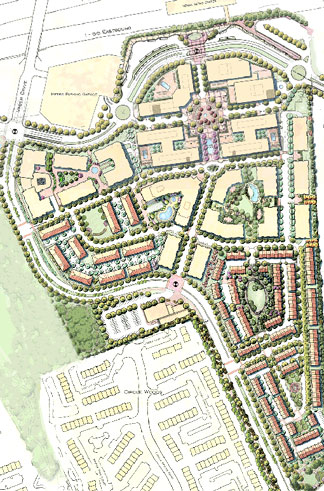When 2250 homes replace 64…

Environmentalists value land preservation. Commuters hate traffic. Home buyers can’t afford single-family homes. There aren’t many inspiring, pedestrian-friendly places to shop, dine and be entertained. Well, Pulte Homes just made a lot of those people happy with MetroWest in Vienna, Virginia.
64 single-family home owners on 60 acres sold their homes at a hefty profit so that Pulte could build 2250 homes, plus 300,000 s.f. of office and 100,000 s.f. of retail (a good sized main street) right up to a major Metro station (top of plan.) At the density of development it replaced, that saves several thousand acres of farmland or wilderness. The density also reduces peak-hour car trips by 47% and 25% for the residences and office respectively, per capita of course. That also means 2250 multi-family homes that are a lot more attainable than their one-acre predecessors. Finally, it also means a town center, a public square and lots of parks to spend time at on the weekday nights and weekends.
Not only that, but it helps set a precedent for other neighborhoods with the same situation, especially when many of the area’s government, nonprofit, business and community leaders are so supportive of it.

This seems like an awfully sophisticated plan for Pulte. Who did it?
Pulte ‘did’ it. If, as a planner, you’re asking who did the master planning, it was a combination of the Lessard Architectural Group, EDAW and RTKL, as listed here.
However, that’s just it, it only takes one ‘sophisticated’ person in Pulte with authority to ensure a plan like this. Interestingly, this very plan is not claimed by any of the aforementioned firms on the website, and a former plan does not include the central plaza. It’s certainly not out of the question that individuals within these development firms are sometimes more sophisticated than the planners they hire.
For instance, planners still try and talk both developers and cities out of pedestrian-only streets (and piazzas are out of the question), the same way traffic engineers try to talk planners out of pedestrian-oriented streets.